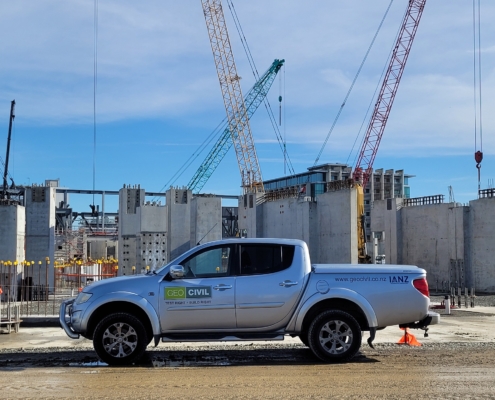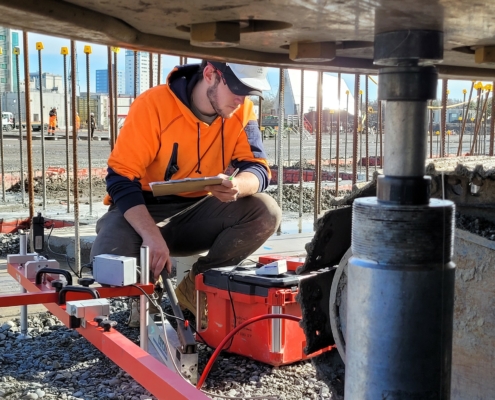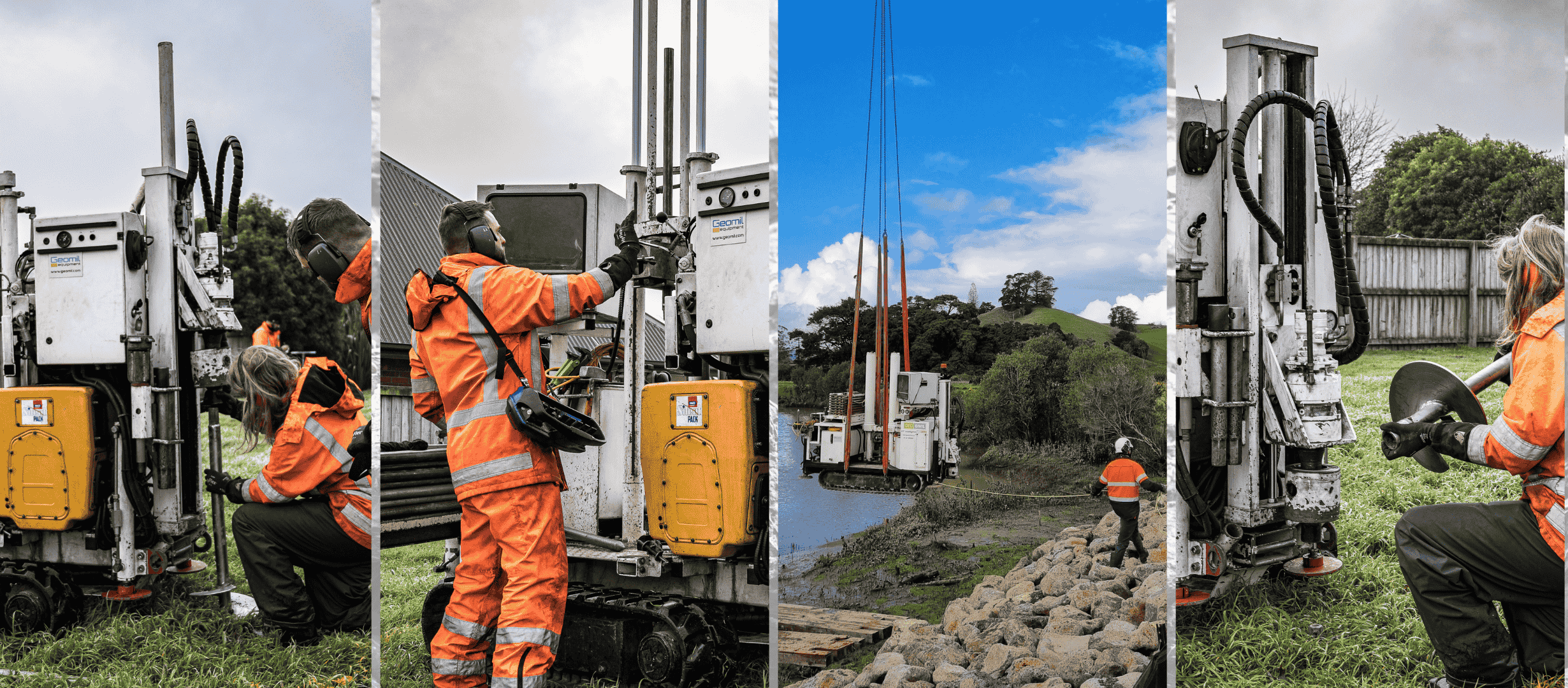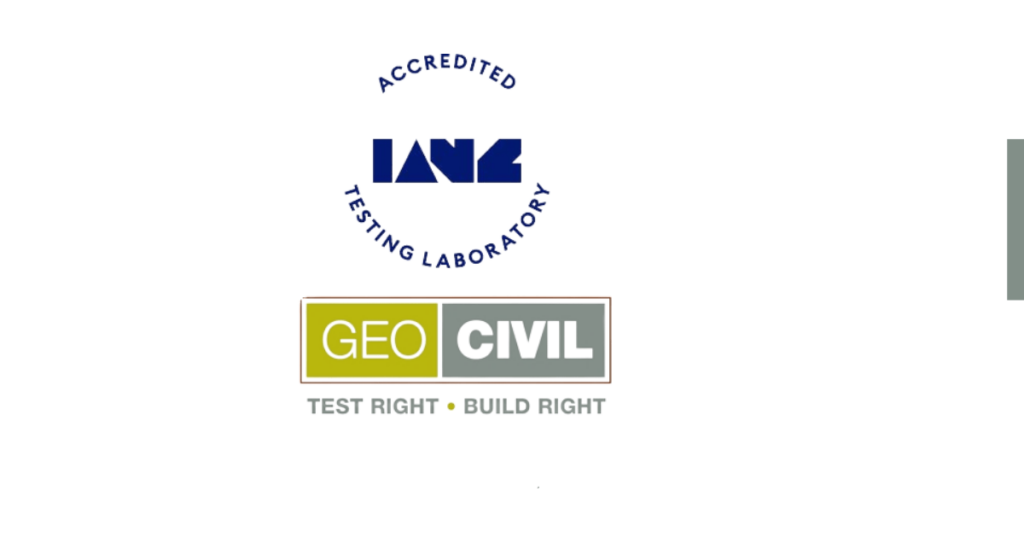The integrated technology of the static plate load tester enables you to manage and control your compaction works, saving both time and cost and to improve the quality of your construction.


For difficult-to-access sites, Window Sampling offers a portable site investigation solution, enabling access to areas a traditional drill rig cannot reach. At our Wellington and Christchurch Offices we have two Window Sampling Kits, allowing us to test deeper than hand augers can into the Wellington Greywacke and through gravelly material which is present in the region. The Window Sampling Kit that we have can reach depths of up to 6-8 meters.
- A petrol breaker drives the steel gouges into the soils and extracted using a two person extraction setup.
- Ideal usage for areas that have restricted access and limited space.
- Excellent for soil and gravel layers.
- All extracted material is logged to NZGS Standard and shear vane and scala readings are also captured.
A cone penetration test is used to determine geotechnical properties of soils. The cone penetration test has become internationally one of the most widely used and accepted test methods for determining geotechnical soil properties.
The cone penetration test can be completed from the ground surface. A cone penetration test rig pushes a steel cone into the ground, generally up to 20m capacity of depth (up to 40m) below the surface or until the cone reaches a hard layer but can be extended if required by client. We are able to use a 10cm2 cone or 15cm2 cone depending on site requirements. The steel cone contains an electronic measuring system that records tip resistance and sleeve friction. As the cone is pushed into the ground, the soil responds with differing degrees of resistance. This resistance is recorded using force sensors in the tip. At the same time as the sensors are recording resistance at the cone tip, sensors in the friction sleeve are recording sleeve friction along a 100mm length. Some cones also have a pore water transducer, which records water pressure in the soil. These readings can be used to determine ground water responses as the cone is pushed through the soils. A cone penetration test typically takes between 45 minutes and 90 minutes. As the cone goes into the ground, measurements are constantly sent back to the rig and recorded on computer.
Cone penetration test results are used by geotechnical engineering specialists to understand the soil properties (the relative density of the soil and the soil behavior type, both of which are calculated from the cone penetration test cone tip resistance and sleeve friction) and how the ground is likely to behave. This information can help in the design of foundations and ground improvements.
Our CPT crews are trained by international experts in their field and carry out all their testing in strict accordance with ASTM D5778-12 or alternatively ISO 22476-1:2006 at the request of the client. Furthermore, all raw data is carefully checked before being dispatched to the client – ensuring the data you receive is of the highest quality achievable. We can also carry out push tube sampling of soils to obtain samples in sands, silts and clays.

For more than 70 years the static plate load test has been well known in international geotechnical practice. This test assesses two important stiffness parameters of the soil: the static soil modulus Es and the subgrade reaction modulus K. Additionally, by unloading and reloading the soil, it can assess the level of compaction achieved, similarly to the approach followed with nuclear density measurements.
The plate load test is extensively used in many countries (for example, Germany, UK, United States) for a range of different applications. Some of them are:
- Pavements and airfields: Assessment of compaction for base and subbase layers; assessment of compressibility of subgrade
- Ground treatment: Assessment of soil treatment effectiveness; for example lime stabilized soils or reinforced soils with geogrid
- Railways: Assessment of track ballast performance
- Landfills, abandoned mines or quarries, site re-developments: Assessment of the existing compaction level and expected future performance
However, for a number of reasons up until now, the static plate load test has not been well established in New Zealand practice. Such reasons potentially include:
- The required reaction mass; a heavy plant such as an excavator is required
- A relatively long test time
- The mobilization of relatively heavy equipment for performing the test (plates, jacks, strain gauges) and issues around their compatibility, calibration, accuracy and sensitivity
- Practical issues around monitoring three strain gages and the required level of expertise required in the field by technicians
- The time required for the interpretation of results and the disparity among different standards and available methods. The choice of method for estimating E and K is often at the discretion of the engineer. The resulting E and K can be quite variable when using different methods with the same data.
- Health and safety issues arising from the presence of the technician under the heavy plant recording during the test.
The development in recent years of the integrated static plate load tester has eliminated all of these issues listed above. This equipment uses the international standard DIN 18134:2012-04 which provides a robust mathematical algorithm with which E and K are both estimated in a consistent manner.
The advantages of the integrated plate load tester are:
- Direct estimation while on site of modulus Ev1 and reload modulus Ev2 with digital printout of results based on the DIN 18134:2012-04 mathematical algorithm; this saves a lot of interpretation time for the geotechnical engineer
- Fast and robust estimation for K based on the same DIN standard as above
- Assessment of soil compaction based on the ratio of Ev2/Ev1
- 20 minutes assembling time and 40 minutes typical testing time per point
- The testing equipment has a robust and compact design
- Elimination of three strain guages by using digital data acquisition through a measuring bridge with 300, 600 and 762mm plates
- By using 600 and 762mm plate sizes, coarser soil materials can be assessed
- Elimination of health and safety issues: after equipment assembly, no operator is located under the counterweight during the test
- Data transfer through USB interface to an analysis software, Bluetooth technology and GPS for accurate mapping of the measuring point
- Fully calibrated digital and mechanical equipment
- Interpretation software that supports results reporting in a straightforward manner
- Another advantage the test offers is that the plate sizes available have closely similar dimensions to the typical foundation geometries encountered in residential buildings described in NZS 3604. By applying proper stress levels under the plate, the test can successfully simulate the behavior of the actual foundation under design or assessment.
A sufficiently heavy plant is still required to provide the counter weight on site and this is selected based on the estimated level of applied stress.
The new integrated static plate load tester will now allow the engineer to choose an efficient option to measure the two important stiffness parameters discussed above.
As part of the Kaikoura earthquake response, North Canterbury Transport Infrastructure Recovery (NCTIR) has engaged the services of Geocivil to help gather data on one of their trial to determine if they could use slip material as roading aggregate.
As part of this trial, Geocivil has tested the slip material for particle size distribution and has also concluded several tests on trial areas using the Static Plate Load Tester (PLT) and Light Weight Deflectometer (LWD) to assess how the slip material performs and establish if it will meet the required specification.
In addition to this trial, Geocivil’s LWD capabilities have been used to confirm the bearing capacity of the soil beneath a section of the railway track. The LWD has proven to be a great application for this type of work as it is fast, easy and cost effective.

